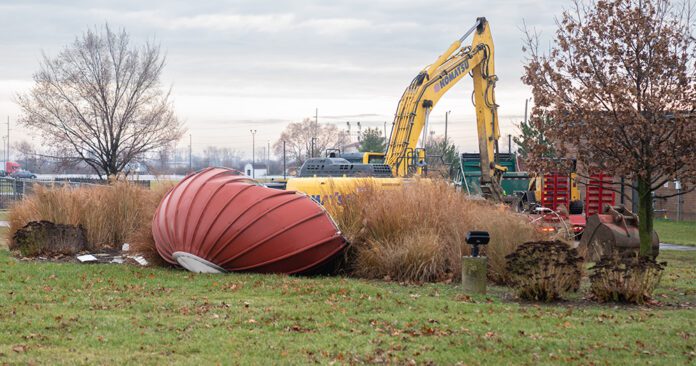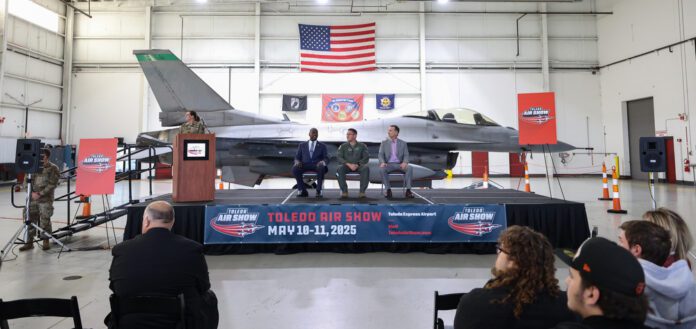Iconic Owens CC silo demolished


Age, decay reasons for downfall of landmark
By Jeremy Schneider (Press Release)
PERRYSBURG – It has stood at the intersection of Oregon Rd. and Biniker Dr. before there was an intersection; before there was even an Owens Community College. Now, the iconic silo that’s welcomed visitors to campus for nearly 60 years is gone.
Due to its age and resulting safety concerns, demolition of the silo began Monday morning, and it only took 15 minutes to wipe out that 40-foot landmark.



Noticeable leaning of the structure prompted Owens officials to evaluate the silo. Marietta Inspection Services recommended that the silo be demolished because of its age and condition and noted it could not be preserved.
The Klumm Bros., a demolition contractor out of Lucas County, dismantled the silo from the top down. The debris was hauled away and will be recycled.
A first inspection was completed on the silo in 2016 because of leaning, but it was determined to be structurally safe at that time.
There is no known documentation to specify exactly how old the silo is, but it was in place when Owens made its first land purchase from Clarence and Mary Biniker in 1971. Two more purchases, in 1986 and 1991, brought the total land purchased from the Biniker family farm to approximately 65 acres, leading to the completion of the east side of the Owens campus.
Nearly 20 percent of the Owens Toledo-area Campus’ 368 acres was formerly part of the Biniker family farm.
The silo, along with the Biniker farmhouse, was part of the 1991 purchase. That land is now the site of the Galleria Complex, which includes the new Healthcare Education Center, Center for Fine and Performing Arts and the Student Health and Activities Center, among other facilities.


“What a story that silo could tell if it could talk. From the foundational practice of farming in Ohio to the development and growth of Owens Community College, the silo has stood guard over the Biniker farm and Owens,” Owens president Dr. Dione D. Somerville said. “As Owens approaches its 60th anniversary, we must consider the continued evolution of our physical structures and their safety and footprint on our campus.
“We are saddened by this development as the silo represents an important part of Owens’ history, but the safety of our college community is always our top priority,” she said.
The east-to-west roadway through the eastside of campus is named in honor of the family whose sale of the land led to the expansion of the Toledo-area Campus.
Ray Chapman’s tragic story
Cleveland author’s book profiles the Toledo Mud Hen
It was the top of the fifth inning when Ray Chapman settled his 5-foot-10 frame into the batter’s box at the Polo Grounds in New York City.
The Yankees’ pitcher that day was right-hander Carl Mays, an infamous “headhunter” who was known for intentionally throwing at opposing hitters. Chapman, nearing the end of his career as the shortstop for the Cleveland Indians, knew this.
Chapman was not wearing a batting helmet. None of the players wore helmets back then. The day was Aug. 16, 1920. Less than 12 hours later, the 29-year-old Chapman, known for his speed and rifle arm, would die from a depressed skull fracture.


The fastball Mays threw hit Chapman in the temple with such force that Mays said later he thought the pitch hit the end of Chapman’s bat. Mays simply fielded the ball and threw to first base.
This tragedy has long been a part of baseball lore. To this day, Chapman, the son of a coal miner from Beaver Dam, Ky., is the only player to die in a major league baseball game.
Author Scott Longert, 70, a Cleveland native now living in Beachwood, knew parts of Chapman’s tragic story and chose the topic for his seventh book, Love and Loss: The Short Life of Ray Chapman. The book is 177 pages and was published by Ohio University Press in late August.
“I had this idea maybe three years ago,” Longert said. “I thought about Chapman for a while. Ohio University gave me a contract, and I did the research and we went from there. Chapman wasn’t born in Ohio, but he played in Toledo and played in Cleveland, so there was a good Ohio connection to it.
“Quite a bit about Chapman’s life was a rags to riches story. He played semi-pro ball and played for the Mud Hens for two years. He was considered the best shortstop in the American League.”
Chapman married Katie Daly, whose father, Martin, owned the Cleveland-based East Ohio Gas Company, the largest gas company in the country for many years.
“Katie was a very accomplished woman,” Longert said. “She went to school in Toledo, and her family had a house in the West End. They moved to Cleveland, and that’s where she met Ray. They had the perfect life.
“His father-in-law built them a home as a wedding present, and he was set at the height of his career. Life was great. He served with the Navy in World War I and probably would have gone on to great things. I just wanted to tell this story so people could learn about him and what he was about.”
One of Longert’s other books, Addie Joss: King of Pitchers (1998), profiles Hall of Fame pitcher Addie Joss, who pitched for the Mud Hens from 1900-01 and wrote sports for the old Toledo News-Bee. Joss also went on to play for the Indians.


Thom Ovacek, a commercial producer at WTOL in Toledo, met Longert a few years ago while making a video on Joss. The video includes interviews with Longert and Mud Hens historian and author John Husman.
“The strange similarities are Chapman and Joss both played for two years for the Mud Hens before moving to Cleveland,” Ovacek said. “I work at WTOL and we were looking for something to do for opening day (2021). I did a three-minute video for the news and a 10-minute version.
“It was the 110th anniversary of the passing of Addie Joss (tuberculous meningitis) and I wanted to put a Toledo spin on it. I grew up in Cleveland and loved Cleveland baseball, and Scott was a connection from Toledo and Cleveland. I read his book (on Joss) and decided we should tell this story on the news if possible.”
Longert said Love and Loss covers Chapman’s life from when he was a young boy through the aftermath of his death, and what became of his family, notably Katie and their daughter, Rae.
“People still go to his grave in Cleveland and leave baseballs and gloves,” Longert said.
Whatever happened to Mays, the pitcher who threw the fastball that ended Chapman’s life?
“This did not really affect his career at all,” Longert said. “He came back to pitch five days later and never showed any remorse. That just made his reputation worse and was probably what kept him out of the Hall of Fame.”
Love and Loss: The Short Life of Ray Chapman can be ordered online at ohioswallow.com.
DAILY DOSE | THE HUMORISTS
Editorial cartoon by Don Lee for the Toledo Free Press.
Felony flag on the play!
Addressing resistance to childhood vaccinations
The question I am often asked is whether or not parents should vaccinate their children. In fact, in our practice, there seems to be more resistance to vaccinations since COVID.
I personally feel that one of the reasons there is an increase in resistance is the recent fear that COVID vaccinations were going to be made mandatory across the board. Although my personal stance is in support of the majority of vaccines, I also believe that it should be a parent’s choice.
In human nature, when we tell somebody they “have to do something,” there is usually resistance and often a reaction to do the opposite. As strongly as I believe in most vaccines, I also feel as strongly that parents should have a choice.
As providers, I believe it is our job to educate parents about the risks and benefits of vaccines. We should be educating them about the diseases vaccines prevent, as well as teaching them about the repercussions of contracting the diseases. That should be in both verbal and written form at all of their well care visits. This is another important reason to have their scheduled well care visits, as set by the American Academy of Pediatrics.
I have frequently been asked, especially by other providers, why I will continue to see patients whose parents will not allow their child to be vaccinated. And I have a few reasons. To reiterate, I believe it is the parent’s right to make that choice for their child. It is also not the child’s choice; it is the parent’s choice, so by not seeing the child who are we, as providers, punishing?
If there are no providers that will see children who are not vaccinated, they will have to resort to using urgent cares and emergency rooms, as this will be the only form of healthcare available to them. Not only does this overwhelm the urgent cares and the emergency rooms for issues that should be seen in primary care office, it is also not good continuity of care for the child.
Also, in an urgent care or ER, you do not always see the same provider, and there is not a fluent record that can be read and obtained with each visit.
I think as providers we have to ask ourselves, why did we get into medicine to begin with? For me, it was to take care of patients, and I feel the best way to do that is to provide them with adequate education, good continuity of care, and to be available to them when they are ill. If I do not see unvaccinated children, I am not providing the care I feel is best for them.
With all that being said, here is why I think children should be vaccinated:
- Vaccines have been successful, in that we no longer see many of the diseases that used to cause severe illnesses and lasting disabilities. For example, whooping cough, tetanus, polio and meningitis are rarely seen in children anymore.
- There is a lot of information online that scares parents away from getting vaccines. Here is a video directly from the American Academy of Pediatrics’ healthychildren.org, where you can also find a lot medically researched information, access to immunization schedules, the specific vaccines and the diseases that they prevent.
In conclusion, I do support the majority of vaccines, but I also strongly support the parent’s right to choose. I can respect any choice a parent makes, as long as it is an educated choice – and when I say an educated choice, it needs to be one that is made from medically sound, researched information, not from just anything that pops up on a Google search.
It is our job as providers to present that information and educate our parents, and then allow them to make the choice.
Stacy Lewis hosts new golf classic


Toledo’s 40-year LPGA event gets new name, format
SYLVANIA – The annual LPGA Tour as we’ve known it, played on the rolling hills of Highland Meadows Golf Club in Sylvania for 40 years, has come to an end.
The tournament, originally the Jamie Farr Toledo Classic, has had several different sponsors over the years. Marathon, Kroger and, most recently the Dana Open, have all supported the Toledo event and helped it generate over $14 million for 215 Toledo area children’s charities.
Next year the tour will be called the Greater Toledo Classic hosted by Stacy Lewis, and in keeping with the tour’s charity tradition, proceeds from that tournament will be distributed to several Toledo-area children’s charities.
Toledo Classic, Inc. director Judd Silverman said he is very proud of the fact that the tournament has raised that large amount of charity funds.




“With $335,000 being distributed from the 2024 Dana Open, we hope the total dollars generated will reach over $15 million after the 2025 event,” he said.
The Greater Toledo Classic will be held July 21-27. It’s a dual tournament and will feature 102 EPSON Tour players and 42 familiar LPGA Legends, who Toledo golf fans have watched for years.
It will be contested over 54 holes at Highland Meadows. In a unique twist, one Legends Tour player will be included in each threesome, with two EPSON Tour players, for the final round on Sunday.


Stacy Lewis, born in Toledo, 13-time LPGA winner and captain of the successful Solheim Cup Team the past two years, has participated in and supported the Toledo LPGA tournament since her amateur days at the University of Arkansas.
“It’s an honor to lend my name to this event and keep professional golf and the LPGA in Toledo. Most importantly, this event will celebrate our past while preparing the future LPGA stars,” she said.
“In addition to the dual tournament, we plan on having events for the Legends Tour players to spend time with the younger women to take advantage of a great mentorship opportunity,” she noted.
“We hope those relationships extend far beyond the week of the tournament. This new event is a fantastic opportunity for the golf fans in the Toledo area to see familiar faces from the past 40 years,” Lewis said.
Tournament week will include four pro-ams, the Women’s Leadership Summit, and other events local golf fans have come to enjoy.


“We are happy to bring the Legends of the LPGA together with the future stars of the LPGA in a never- been-done-before format featuring two tournaments at the same time,” explained Silverman.
“After 40 years, we thought it was time to try something different that will bring back many of the players that have competed in Toledo over the years, along with the up-and-coming future LPGA stars,” he said.
“We’re incredibly grateful to Stacy Lewis agreeing to serve as tournament host. Her exceptional leadership has been on full display the past two years as the U.S. Solheim Cup captain. Her presence will be a huge benefit to the EPSON Tour players.”





















